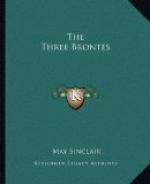It is difficult to pick out from the confusion of these unsorted fragments all the heroes of Emily Bronte’s saga. There is Gleneden, who kills a tyrant and is put in prison for it. There is Julius Angora, who “lifts his impious eye” in the cathedral where the monarchs of Gondal are gathered; who leads the patriots of Gondal to the battle of Almedore, and was defeated there, and fell with his mortal enemy. He is beloved of Rosina, a crude prototype of Catherine Earnshaw. “King Julius left the south country” and remained in danger in the northern land because a passion for Rosina kept him there. There is also Douglas of the “Ride”. He appears again in the saga of the Queen Augusta, the woman of the “brown mountain side”. But who he was, and what he was doing, and whether he killed Augusta or somebody else killed her, I cannot for the life of me make out. Queen Augusta, like Catherine Earnshaw, is a creature of passion and jealousy, and her lover had been faithless. She sings that savage song of defiance and hatred and lamentation: “Light up thy halls!”
Oh! could I see thy lids weighed down
in cheerless woe;
Too full to hide their tears, too stern
to overflow;
Oh! could I know thy soul with equal grief
was torn,
This fate might be endured—this
anguish might be borne.
How gloomy grows the night! ’Tis
Gondal’s wind that blows;
I shall not tread again the deep glens
where it rose,
I feel it on my face——Where,
wild blast! dost thou roam?
What do we, wanderer! here, so far away
from home?
I do not need thy breath to cool my death-cold
brow;
But go to that far land where she is shining
now;
Tell her my latest wish, tell her my dreary
doom;
Say that my pangs are past, but hers
are yet to come.
And there is Fernando, who stole his love from Zamorna. He is a sort of shadowy forerunner of Edgar Linton.
There is the yeoman Percy, the father of Mary whom Zamorna loved. And there is Zamorna.
A large group of poems in the legend refer, obviously, I think, to the same person. Zamorna is the supreme hero, the Achilles of this northern Iliad. He is the man of sin, the “son of war and love”, the child “unblessed of heaven”, abandoned by its mother, cradled in the heather and rocked by the winter storm, the doomed child, grown to its doom, like Heathcliff. His story is obscure and broken, but when all the Zamorna poems are sorted from the rest, you make out that, like Heathcliff, he ravished from her home the daughter of his mortal enemy (with the difference that Zamorna loves Mary); and that like Heathcliff he was robbed of the woman that he loved. The passions of Zamorna are the passions of Heathcliff. He dominates a world of savage loves and mortal enmities like the world of Wuthering Heights. There are passages in this saga that reveal the very aspect of the soul of Heathcliff. Here are some of them.




